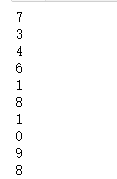import tempfile import tensorflow as tf # 1. 从数组创建数据集。 input_data = [1, 2, 3, 5, 8] dataset = tf.data.Dataset.from_tensor_slices(input_data) # 定义迭代器。 iterator = dataset.make_one_shot_iterator() # get_next() 返回代表一个输入数据的张量。 x = iterator.get_next() y = x * x with tf.Session() as sess: for i in range(len(input_data)): print(sess.run(y))

# 2. 读取文本文件里的数据。 # 创建文本文件作为本例的输入。 with open("E:\test1.txt", "w") as file: file.write("File1, line1. ") file.write("File1, line2. ") with open("E:\test2.txt", "w") as file: file.write("File2, line1. ") file.write("File2, line2. ") # 从文本文件创建数据集。这里可以提供多个文件。 input_files = ["E:\test1.txt", "E:\test2.txt"] dataset = tf.data.TextLineDataset(input_files) # 定义迭代器。 iterator = dataset.make_one_shot_iterator() # 这里get_next()返回一个字符串类型的张量,代表文件中的一行。 x = iterator.get_next() with tf.Session() as sess: for i in range(4): print(sess.run(x))

# 解析TFRecord文件里的数据。 # 解析一个TFRecord的方法。 def parser(record): features = tf.parse_single_example(record,features={'image_raw':tf.FixedLenFeature([],tf.string),'pixels':tf.FixedLenFeature([],tf.int64),'label':tf.FixedLenFeature([],tf.int64)}) decoded_images = tf.decode_raw(features['image_raw'],tf.uint8) retyped_images = tf.cast(decoded_images, tf.float32) images = tf.reshape(retyped_images, [784]) labels = tf.cast(features['label'],tf.int32) #pixels = tf.cast(features['pixels'],tf.int32) return images, labels # 从TFRecord文件创建数据集。这里可以提供多个文件。 input_files = ["F:\output.tfrecords"] dataset = tf.data.TFRecordDataset(input_files) # map()函数表示对数据集中的每一条数据进行调用解析方法。 dataset = dataset.map(parser) # 定义遍历数据集的迭代器。 iterator = dataset.make_one_shot_iterator() # 读取数据,可用于进一步计算 image, label = iterator.get_next() with tf.Session() as sess: for i in range(10): x, y = sess.run([image, label]) print(y)

# 使用initializable_iterator来动态初始化数据集。 # 从TFRecord文件创建数据集,具体文件路径是一个placeholder,稍后再提供具体路径。 input_files = tf.placeholder(tf.string) dataset = tf.data.TFRecordDataset(input_files) dataset = dataset.map(parser) # 定义遍历dataset的initializable_iterator。 iterator = dataset.make_initializable_iterator() image, label = iterator.get_next() with tf.Session() as sess: # 首先初始化iterator,并给出input_files的值。 sess.run(iterator.initializer,feed_dict={input_files: ["F:\output.tfrecords"]}) # 遍历所有数据一个epoch。当遍历结束时,程序会抛出OutOfRangeError。 while True: try: x, y = sess.run([image, label]) except tf.errors.OutOfRangeError: break